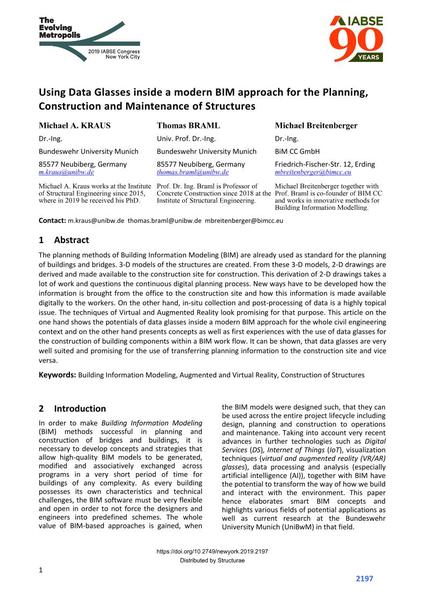Using Data Glasses inside a modern BIM approach for the Planning, Construction and Maintenance of Structures

|
|
|||||||||||
Bibliographic Details
| Author(s): |
Michael A. Kraus
(Bundeswehr University Munich)
Thomas Braml (Bundeswehr University Munich) Michael Breitenberger (BiM CC GmbH) |
||||
|---|---|---|---|---|---|
| Medium: | conference paper | ||||
| Language(s): | English | ||||
| Conference: | IABSE Congress: The Evolving Metropolis, New York, NY, USA, 4-6 September 2019 | ||||
| Published in: | The Evolving Metropolis | ||||
|
|||||
| Page(s): | 2197-2202 | ||||
| Total no. of pages: | 6 | ||||
| DOI: | 10.2749/newyork.2019.2197 | ||||
| Abstract: |
The planning methods of Building Information Modeling (BIM) are already used as standard for the planning of buildings and bridges. 3-D models of the structures are created. From these 3-D models, 2-D drawings are derived and made available to the construction site for construction. This derivation of 2-D drawings takes a lot of work and questions the continuous digital planning process. New ways have to be developed how the information is brought from the office to the construction site and how this information is made available digitally to the workers. On the other hand, in-situ collection and post-processing of data is a highly topical issue. The techniques of Virtual and Augmented Reality look promising for that purpose. This article on the one hand shows the potentials of data glasses inside a modern BIM approach for the whole civil engineering context and on the other hand presents concepts as well as first experiences with the use of data glasses for the construction of building components within a BIM work flow. It can be shown, that data glasses are very well suited and promising for the use of transferring planning information to the construction site and vice versa. |
||||
| Keywords: |
virtual reality Building Information Modeling augmented reality construction of structures
|
||||
